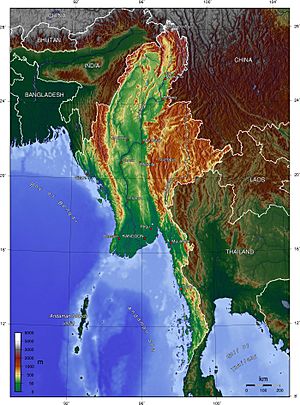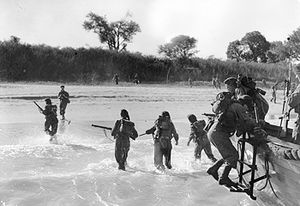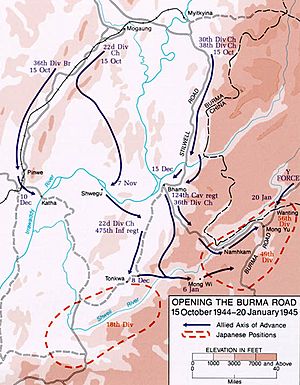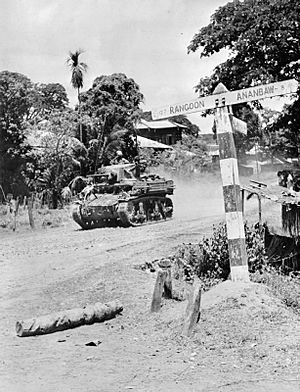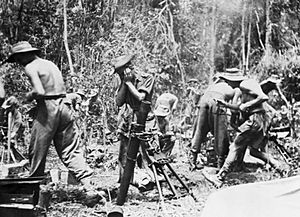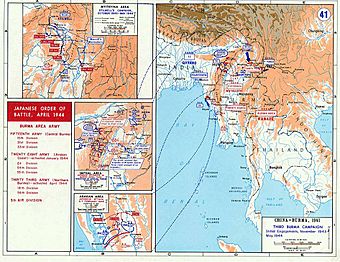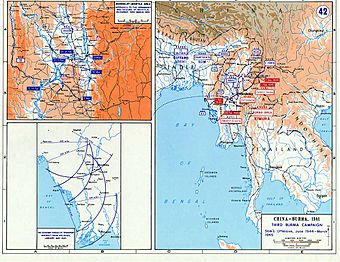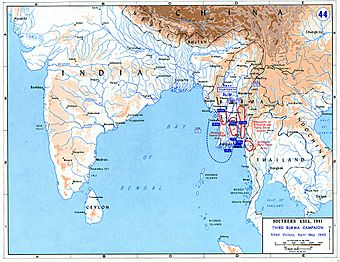Burma campaign (1944–1945) facts for kids
{{Infobox military conflict | conflict = Burma campaign 1944–1945 | partof = the Burma campaign during World War II | image = File:British soldiers patrol Burmese town Bahe.jpg | image_size = 300px | caption = Two British soldiers patrol the ruins of Bahe in Federated Shan States, Central Burma, January 1945. | date = November 1944 – 7 August 1945 | place = Burma | result = Allied victory
- End of the Japanese occupation
- The disbandment of the INA
- Combat continues until September 13
| territory = Burma returned to British control | casus = | combatant1 = Allies
{{clist|bullets=yes|title=![]() British Empire |
British Empire |![]() United Kingdom |
United Kingdom |![]() India |
India |![]() Burma |
Burma |![]() Nepal |
Nepal |![]() Gambia |
Gambia |![]() Gold Coast |
Gold Coast |![]() Kenya |
Kenya |![]() Nigeria |
Nigeria |![]() Northern Rhodesia |
Northern Rhodesia |![]() Southern Rhodesia |
Southern Rhodesia |![]() Nyasaland |
Nyasaland |![]() [[Uganda Protectorate|Uganda}}
[[Uganda Protectorate|Uganda}}
 China
China United States
United States Patriotic Burmese Forces
Patriotic Burmese Forces- Medical support:
 Belgian Congo
Belgian Congo
 State of Burma
State of Burma Azad Hind
Azad Hind
| commander1 =
 Louis Mountbatten
Louis Mountbatten William Slim
William Slim Wei Lihuang
Wei Lihuang Aung San
Aung San
| commander2 =
 Heitarō Kimura
Heitarō Kimura Masaki Honda
Masaki Honda Shōzō Sakurai
Shōzō Sakurai Subhas Chandra Bose
Subhas Chandra Bose Ba Maw
Ba Maw
| strength1 = | strength2 =
| casualties1 =
- 22,262 (British Commonwealth)
- 102 tanks destroyed
| casualties2 =
- 31,119
| campaignbox =
}} The Burma campaign (1944–1945) was a major part of World War II in Southeast Asia. It was fought mainly by forces from the British Commonwealth, China, and the United States. They fought against Japan and its allies, which included the Burma National Army, the Indian National Army, and Thailand. British Commonwealth forces came from the United Kingdom, British India, and various parts of Africa.
This campaign was one of the longest of the war. This was partly because heavy monsoon rains meant fighting was only possible for about half the year. In 1942, Japan had taken over Burma, pushing British, Indian, and Chinese forces out. The British government in Burma had to flee to India. After some successful defenses in 1943, Japan tried to stop the Allies in 1944 by invading India. This attack failed badly.
Starting in December 1944, the Allies launched several attacks into Burma. American and Chinese forces from northern Burma joined up with Chinese armies from Yunnan province. This allowed the Allies to finish building the Burma Road in the final months of the war. In the coastal area of Arakan, Allied forces landed from the sea. They captured important islands and caused many losses for Japan.
In Central Burma, the Allies crossed the Irrawaddy River. They defeated the main Japanese armies there. Allied troops then moved towards Rangoon, the capital city and main port. Japanese forces tried to slow them down until the monsoon rains started. However, an Allied attack from the air and sea secured the city, which the Japanese had already left.
Just before the war ended, Japanese forces trapped in Southern Burma tried to escape across the Sittang River. They suffered huge losses.
Planning the Burma Campaign
As the monsoon rains ended in late 1944, the Allies prepared for big attacks into Japanese-controlled Burma. The main Allied headquarters for British, Indian, and American forces was South East Asia Command. It was based in Ceylon (now Sri Lanka) and led by Admiral Louis Mountbatten.
Allied Strategy for Victory
The Allies had three main plans:
- Plan "X": The main attack would come from the American-led Northern Combat Area Command (NCAC). They would get help from the British Fourteenth Army. The NCAC would link up with Chinese armies attacking from Yunnan province. The goal was to finish the Ledo Road. This road would connect India with China, helping to deliver supplies.
- Plan "Y": The main attack would be by the Fourteenth Army. They would cross the Chindwin River into Central Burma. Their goal was to capture Mandalay and meet up with the NCAC and Chinese forces.
- Plan "Z": This plan involved a major attack by sea and air on Rangoon, Burma's capital and main port. If successful, it would cut off Japanese forces in Burma.
It turned out that the ships and aircraft needed for Plan "Z" would not be ready until the war in Europe was over. So, the Allies decided to go with Plan "Y", which was renamed Operation Capital. Under this plan, the Fourteenth Army would lead the main attack into Central Burma. This area was good for British and Indian armored vehicles. The NCAC and Chinese forces would make smaller advances. The XV Corps would capture the coastal area of Arakan. This would secure airfields to supply the Fourteenth Army.
Japanese Defense Plans
After their defeats in 1943, the Japanese changed their command. Lieutenant General Hyotaro Kimura took over the Burma Area Army. He was good at logistics, meaning he could manage supplies. Japan hoped he could make his army self-sufficient using Burma's resources. However, Allied air attacks made it hard for Japan to get supplies. Only about half of the planned reinforcements reached Burma.
Kimura knew his army was weak from past battles and lacked equipment. Instead of fighting near the Chindwin River, he pulled his main army, the Fifteenth Army, back behind the Irrawaddy River. They would defend this river against the British Fourteenth Army. The Twenty-Eighth Army would defend the Arakan coast. The Thirty-Third Army would try to stop the new road link between India and China.
Burmese People Change Sides
Another important factor was how the Burmese people felt. In 1942, many Burmese had helped the Japanese invade. Japan set up a government in Burma led by Ba Maw and created the Burma National Army under Aung San. But Japan still controlled the country. Their strict rule and wartime hardships turned the Burmese against them.
Aung San secretly planned to turn against the Japanese. In early 1945, he asked for help from an Allied group called Force 136. This group was already helping local resistance fighters. The Allies decided to support Aung San. Force 136 helped the entire Burma National Army switch sides to the Allies.
Indian National Army's Role
The Indian National Army (INA) was another force under Japanese control. It was made up mostly of former Indian prisoners of war and volunteers. Its leader was Subhas Chandra Bose. During the 1945 campaign, some INA units fought bravely. But many others left or surrendered easily. The Japanese had upset many INA soldiers by not giving them enough supplies or using them for labor instead of fighting.
Key Battles of the Campaign
Southern Front: Arakan Coast
The Japanese Twenty-eighth Army defended the coastal Arakan region. Allied forces here were led by the XV Indian Corps. Their first goal was Akyab Island, which had an important port and airfield. The Allies needed this base to fly supplies to troops in Central Burma.
The XV Corps attacked Akyab for the third time. Indian and African divisions advanced, cutting off Japanese supply lines. The Japanese left Akyab Island on December 31, 1944. The Allies took it without a fight two days later.
Next, Allied forces attacked south along the coast. They made landings from the sea to trap Japanese troops. British commandos and Indian troops fought fiercely to clear peninsulas and secure waterways. After heavy fighting, the Allies captured the village of Kangaw. The Japanese were forced to scatter, losing many soldiers and equipment.
With the coast secure, the Allies built airbases on Ramree Island and Cheduba Island. The Battle of Ramree Island lasted six weeks. The Japanese garrison suffered heavy losses from disease, hunger, and Allied attacks.
After these battles, XV Corps operations were reduced. This was to free up transport aircraft to help the Fourteenth Army.
Northern Front: Linking India and China
The Japanese Thirty-third Army defended Northern Burma against attacks from India and China. The American and Chinese Northern Combat Area Command (NCAC) advanced south. Chinese armies from Yunnan also attacked.
Even though many NCAC troops were sent to fight Japanese attacks in China, the command continued its advance. British forces on the right flank moved south and met the Indian Division on December 10, 1944. This created a continuous front for the Allies. On the left, the Chinese New 1st Army advanced from Myitkyina to Bhamo, which fell on December 15.
The Chinese New 6th Army moved through difficult terrain to threaten Japanese supply lines. American and Chinese units tried to cut the Burma Road behind the Japanese. They didn't completely trap the Japanese, but they made them retreat faster.
The Chinese New First Army met the Chinese armies from Yunnan on January 21, 1945. This meant the Ledo Road was finally completed. The first truck convoy from India reached Kunming, China, on February 4.
Chinese leader Chiang Kai-shek ordered the NCAC to stop its advance at Lashio, which was captured on March 7. The Japanese had already moved their 18th Division to Central Burma. By early April, the Japanese 56th Division also left the northern front.
From April 1, NCAC operations stopped. Its units returned to China. The British 36th Division moved to Mandalay and then returned to India.
Central Front: Mandalay and Meiktila
The Japanese Fifteenth Army defended Central Burma. They fell back behind the Irrawaddy River, leaving small groups to slow the Allied advance.
The British Fourteenth Army made the main Allied attack, called Operation Capital. It had two corps, with six infantry divisions and two armored brigades. Supplying this large army was a challenge. A system using air transport and improved land routes was put in place.
Allied troops crossed the Chindwin River. When they realized the Japanese had moved behind the Irrawaddy, the plan changed. One corps would continue towards Mandalay. The main part of the other corps would move to the west, cross the Irrawaddy near Pakokku, and capture Meiktila, a key Japanese supply center. This new plan worked because the Japanese didn't know how strong the Allied force moving on Pakokku was.
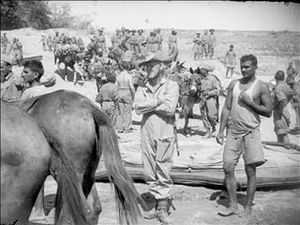
In January and February, the XXXIII Corps cleared the Shwebo plain and crossed the Irrawaddy near Mandalay. This drew Japanese attention. Meanwhile, the IV Corps, led by the 7th Indian Division, crossed the Irrawaddy near Pakokku. The 17th Indian Division and an armored brigade then advanced rapidly towards Meiktila.
Battle for Meiktila
Central Burma is an open plain with good roads. The fast-moving 17th Indian Division and armored brigade surprised the Japanese. They attacked Meiktila on March 1 and captured it in four days.
Japanese reinforcements arrived too late to save the garrison. They then surrounded Meiktila, trying to take it back and destroy the 17th Indian Division. Even though many Japanese regiments were involved, their attacks were not well-coordinated. The 17th Indian Division was reinforced by air. British tank and infantry forces attacked out of Meiktila to break up Japanese groups. By the end of March, the Japanese had lost many soldiers and most of their artillery. They stopped the attack and retreated.
Fall of Mandalay
While the Japanese were busy at Meiktila, XXXIII Corps renewed its attack on Mandalay. The city fell to the 19th Indian Division on March 20. The Japanese held the old citadel, called Fort Dufferin, for another week. Many historic parts of Mandalay were destroyed because the Japanese chose to make a last stand there.
With Mandalay captured, Japanese communications to the northern front were cut. The Allied road link between India and China was finally secure.
The fall of Mandalay also led to the Burma National Army changing sides. On March 27, Aung San, their commander, led them in rebellion against the Japanese.
Race for Rangoon
It was very important to capture the port of Rangoon before the monsoon rains began. Heavy rains would make overland supply routes from India unusable and limit air transport. Also, many American transport aircraft were going to be removed from the area. Rangoon was needed to supply the large army and feed the local people.
Some British divisions were sent back to India to reduce supply needs. The XXXIII Indian Corps moved down the Irrawaddy River valley. The IV Corps made the main attack down the Sittang River valley.
The IV Corps advanced quickly. On April 6, they attacked the Japanese at Pyawbwe. A flanking column of tanks and infantry cut the main road behind the Japanese. They attacked the Japanese headquarters, but didn't realize it was an army headquarters.
From this point, the advance to Rangoon faced little organized resistance. At Pyinmana, the town and bridge were captured on April 19 before the Japanese could organize defenses. Lieutenant General Honda and his staff escaped on foot, but they could no longer control their troops.
Some Japanese units tried to block the road to Rangoon at Toungoo. However, a general uprising by Karen guerrillas, who were helped by Force 136, delayed the Japanese long enough for the 5th Indian Division to reach Toungoo first on April 23.
The 17th Indian Division then led the advance and met a Japanese blocking force north of Pegu, about 40 miles north of Rangoon, on April 25. The monsoon rains began, and floods slowed the division's advance.
Operation Dracula: Taking Rangoon
Originally, the plan was for XV Indian Corps to attack Rangoon by sea, called Operation Dracula, much earlier. This would have helped with supply problems. But due to lack of resources, Dracula was delayed.
General Slim worried that the Japanese would defend Rangoon fiercely through the monsoon. So, he asked for Dracula to be brought back quickly. However, the Japanese commander, Kimura, had already ordered Rangoon to be evacuated starting April 22. Many Japanese troops left by sea. Kimura's own headquarters left by land.
On May 1, a Gurkha parachute battalion landed at Elephant Point and cleared Japanese defenses at the mouth of the Rangoon River. On May 2, Allied forces landed near Rangoon. They found the city empty. The leading troops of the 17th and 26th Indian divisions met north of Rangoon on May 6.
Final Battles
After Rangoon was captured, a new British Twelfth Army headquarters was formed. It took control of Allied forces remaining in Burma.
The remaining Japanese forces were trapped in the Pegu Yomas, a range of hills between the Irrawaddy and Sittang rivers. They planned to break out and rejoin the main Japanese army. To help them, the Japanese Thirty-third Army launched a small attack across the Sittang River on July 3.
The breakout by the Twenty-eighth Army on July 17 was a disaster. The British had found the Japanese plans and set up ambushes. Hundreds of Japanese soldiers drowned trying to cross the swollen Sittang River. Burmese guerrillas also killed many stragglers. The breakout cost the Japanese nearly 10,000 men. British and Indian losses were very small.
After the Campaign
General Slim was promoted to lead all Allied land forces in Southeast Asia. The Fourteenth Army and XV Corps headquarters returned to India to plan the next stage of the war.
The next planned operation was an attack on the western coast of Malaya, called Operation Zipper. However, the dropping of the atomic bombs ended World War II. Zipper was still carried out after the war to bring occupation troops into Malaya.
Images for kids


